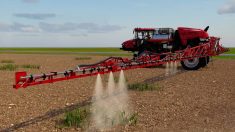Whenever energy prices take a dive in Alberta, cutbacks to government spending are sure to follow. Reports indicate that the provincial government will be short over $3 billion in tax revenue due to depressed bitumen prices. Deputy ministers have been ordered to come up with budget reductions of 10 per cent for their respective departments. It’s a familiar song-and-dance routine, but reducing the deficit is only going to work if all departments are equally included in a big cutback.
The reality is that cutting back the Agriculture Department isn’t going to make much difference in the overall fiscal scheme. The ag budget is peanuts compared to the monster budgets of the big-dog spenders like health, education, and welfare. But those big dogs tend to be yappy, highly political and sacred, so the pressure is usually on the other departments to come up with even more cutbacks. But veteran Ag Department bureaucrats are like the farmers and ranchers they serve — they are used to booms and busts.
Read Also

Guarding against misinformation: Do you believe in house hippos?
Misinformation and disinformation run rampant in today’s digital age. Farmers must be wary of the digital dangers and know how to keep themselves safe.
This old warhorse remembers a few cycles of boom and bust in government spending going back to the Lougheed days. Back then the government flush with cash from high energy prices (it’s hard to believe but $35 a barrel was high back then) went on a diversification spending spree that included the Agriculture Department. Tax money was pumped into every idea with the hope it would bring more industry to the province.
Old-school ag bureaucrats saw that as a blank cheque to increase extension services, a traditional department service that was dear to their hearts. New district agriculturist offices where opened in every small town in Alberta, along with more district home economists (something unique to Alberta). Millions more were spent on livestock diversification, market development and promotion. A new Ag Department head office was also built in Edmonton to house all the new administrators needed to manage the rapidly expanding empire. I believe there were at least five assistant deputy ministers at the time.
Then when energy prices collapsed and the merciless Klein cutback era arrived, all that Ag Department expansion came crashing down. Those glory days lasted about 10 years.
Since that time the Ag Department has had various reincarnations, but it’s a ghost of its former self. That’s probably a good thing, since the ag economy has changed with consolidation and specialization. One of the advantages the Ag Department has over other ministries is that because it is so small, structural changes can be made without a lot of bureaucratic inertia and political consequences.
On the other hand, that causes instability and sees policies change on a whim. Department officials probably shudder whenever a new minister or deputy arrives expecting that they will probably want to launch some new restructuring scheme just so they can make their mark on the department.
One of the realities that affects the extent of any government department cutback has to do with the role of each ministry within the context of its contribution to the economy. That’s where agriculture pales in comparison to such big-dog departments as education, health and welfare. It even loses out to the Environment and Energy departments because those folks deal with more sexy issues like monitoring and emissions. Even though agriculture and food processing are the second-largest sector of the economy, the department’s size relative to that sector is small indeed.
The only thing that upsets that situation is when some climate, market or disease calamity requires a sudden infusion of taxpayer cash. It seems whenever that happens it takes at least a billion dollars to resolve the crisis. To keep those unexpected, unbudgeted expenditures at bay I expect there is probably a group of ag bureaucrats whose main job is just to pray that no such calamities will occur.
But when they do occur, the ag minister of the day has to go cap in hand to the cabinet to beg for help. That hasn’t been easy for many years due to a revolving door of ag ministers — I believe there have been seven in the past nine years, but I have lost track. With all due respect to those ministers, such a temporary nature to the job doesn’t give them much clout around the cabinet table. In reality it probably puts them at a disadvantage whenever a new cutback campaign is launched. Without a lot of experience, political clout and backup in cabinet I suspect all a neophyte ag minister can say to cutback demands is “Yes Ma’am.”
Which brings us to the present situation. The best that can be hoped for is a minor reduction in the department’s budget — not that it matters. Reductions of a few million in the department’s budget is all that is realistically possible, which is pretty insignificant in the big deficit picture. However, department bean counters will be trying to find anything that can be reduced or eliminated. I expect such agencies as ALMA and many ag-related research bodies will see reductions in their budgets. That would be short sighted, as those folks can actually generate more returns to the economy and tax base than most other government bodies.
I am biased, but perhaps the Ag Department needs to be exempted from any big cutbacks being their activities tend to contribute to a net benefit to the taxpayer. Compare that to recent media reports about such spendthrift agencies as Alberta Health Services, where millions were spent on travel, perks and over-the-top salaries. I rest my case.














